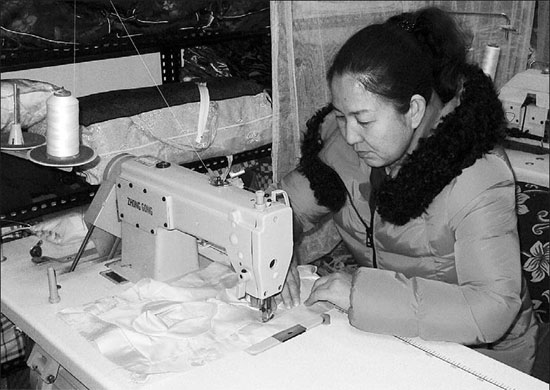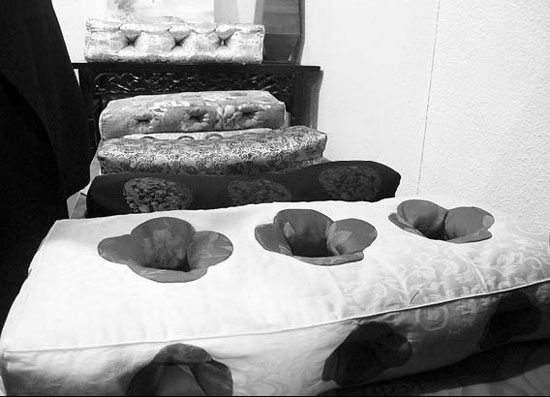A restful pursuit
Updated: 2013-02-05 05:33
By Wang Kaihao (China Daily)
|
||||||||
|
Mou Chunling preserves the declining tradition of making Mongolian-style ear pillows in Tongliao. Photos by Wang Kaihao / China Daily |
Low-pressure pillows have provided a good night's sleep for Genghis Khan's soldiers and modern-day Inner Mongolians. One needlework artist is determined to preserve the tradition, Wang Kaihao reports from Tongliao.
The workshop in the noisy wholesale market is no more than 60 square meters.
It looks a little messy, with 10 sewing machines almost buried under piles of half-finished pillows. Also, the pillows look a little unusual. They are covered in delicate cloth and they have holes on each side.
Mou Chunling, a 47-year-old woman of the Mongolian ethnic group in Tongliao, Inner Mongolia autonomous region, supervises the making of these "ear pillows", so called because the holes are designed to protect the ear from pressure during sleep.
According to local folklore in Tongliao, the ear pillow can be traced back to the era of Genghis Khan (1162-1227), when it was favored by sentry soldiers. Later it became a must-have daily necessity of the royal Manchu family in the Qing Dynasty (1644-1911). But the tradition has declined over the past century.
Mou got into the pillow business in 2007, a trade which she jokingly says she "inherited by blood." Her ancestors were tailors for the Mongol nobles in the time of empress dowager Xiaozhuang (1613-1688), a Mongol concubine in the Qing Dynasty who was born on the Horqin grassland (in today's Tongliao).
The concubine is said to be the one who took the ear pillow to royal Manchu families, and the fashion later spread among the rich nationwide.
When Mou's family got together for her mother's 80th birthday party in 2007, her aunt, who is the fifth generation of ear-pillow makers in her family, made two small pieces as gifts and complained that no one would inherit the skill.
Mou then decided to try it herself, though she knew little about this long-embedded art in her family history except for seeing a few examples in her childhood.
Mou says that sewing had once saved her in a very difficult time earlier in her life.
A native of Bairin Left Bannerin in Inner Mongolia's city of Chifeng, Mou had to quit her teaching job in 1991 to join her husband, who had a new job in Tongliao.
Unable to find a regular job there, Mou tried a variety of temporary works, including being a street vendor and later a construction worker. "I didn't even have money to buy new clothes for my newborn child," she remembers.
She was pushed to pick up sewing needles for the first time in her life. But she gained skill quickly and soon her neighbors were coming to order clothes.
Although she dropped the sewing business soon after she became a successful insurance sales woman, and later opened a store selling precious stones, Mou says she has since dreamed of opening a sewing business as well.
Mou's aunt was her first teacher in making the pillows, but the elderly woman was vague on details since her skills have been neglected for years.
Mou visited museums and was referred to old craftswomen, but she found only a handful who still grasp this traditional skill. They are all in their late 80s. She keeps collecting the dying styles and gives the items a new name: "Xiaozhuang Pillows".
"The most important characteristic for noble families was their intricate detail rather than the flamboyant appearance," Mou says when picking up a spherical pillow. "For example, we have eight stitches within one centimeter of cloth here while there are only four in most regular clothes. The making of such an item is time- and material-consuming."
Mou uses 2.4 meters of cloth (75 cm in width), usually silk or artificial silk, just to make a pillowcase, and much more cloth for its interior.
She can only finish one pillow per day even after acquiring some modern cutting machines in 2012. One item will thus sell from 800 to 2,600 yuan ($125 to $420), which she confesses is too high for local market.
Mou still runs her business of selling precious stones, but she says it has declined because she has been wholly devoted to reviving this Mongolian pillow tradition. However, her pillow sales in 2012 totaled a mere 70,000 yuan, which she says hardly covers the cost.
Despite all the difficulties, she doesn't intend to make any compromises on craftsmanship.
"I don't want to compete with big textile manufacturers in those southern provinces," she says, referring to her small and crowded workshop. "I prefer to call this a prolonged history rather than a commodity."
The "Xiaozhuang Pillow" has been listed as one of the city's intangible cultural heritages, a bonus that has Mou hoping for more support from the municipal government to get more people involved.
According to Wang Xianghong, the city's deputy head of the employment management office, the municipal government has established a project to encourage the city's development of creative entrepreneurs like Mou. It offers workshops for free use and even waives their tax for three years.
Mou fears that her pillows are not qualified to earn an export license because the yield is too small, despite the fact that she has trained about 10 artisans.
"I am worried if someone throws me a big order," Mou says, noting that some luxury hotels in Hohhot, Inner Mongolia's capital, wanted to replace all of their pillows with hers. But the quantity needed was more than she could handle. "And I have to hoard some pillows in case I open an online store."

There have been many replicas on e-commerce retailer Taobao.com after she attended some exhibitions around the country, she says with a sigh. Though most of these pieces are not as delicately made as hers, she worries such mass-produced items will bury her products.
But she says she is glad that the traditional craftsmanship is attracting young enthusiasts.
Zhao Haicun, a Tongliao native who worked in a costume factory in Shenzhen, for three years, returned home due to the slumping export industry in Guangdong province. He ran an ice-cream shop until he found Mou's ambitious project and joined the pillow squad in 2011.
"I didn't know about such a beautiful Mongolian pillow before, though it is made in my hometown," says the 31-year-old.
Zhao says he enjoys his current job with the pillow workshop, since he has the basic skills thanks to his previous job. Plus, he says with a smile, he has "much more free time than in my days in big factories".
Contact the writer at wangkaihao@chinadaily.com.cn.
|
The "Xiaozhuang Pillow" has been listed as an intangible cultural heritage of Tongliao. |
(China Daily 02/05/2013 page20)

 In Photos: 7.0-magnitude quake hits Sichuan
In Photos: 7.0-magnitude quake hits Sichuan
 Li Na on Time cover, makes influential 100 list
Li Na on Time cover, makes influential 100 list
 FBI releases photos of 2 Boston bombings suspects
FBI releases photos of 2 Boston bombings suspects
 World's wackiest hairstyles
World's wackiest hairstyles
 Sandstorms strike Northwest China
Sandstorms strike Northwest China
 Never-seen photos of Madonna on display
Never-seen photos of Madonna on display
 H7N9 outbreak linked to waterfowl migration
H7N9 outbreak linked to waterfowl migration
 Dozens feared dead in Texas plant blast
Dozens feared dead in Texas plant blast
Most Viewed
Editor's Picks

|

|

|

|

|

|
Today's Top News
Live report: 7.0-magnitude quake hits Sichuan, heavy casualties feared
Boston suspect cornered on boat
Cross-talk artist helps to spread the word
'Green' awareness levels drop in Beijing
Palace Museum spruces up
First couple on Time's list of most influential
H7N9 flu transmission studied
Trading channels 'need to broaden'
US Weekly

|

|









